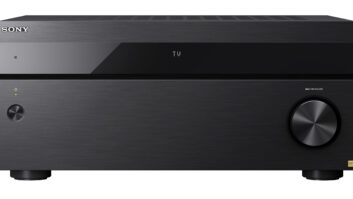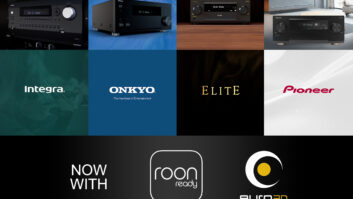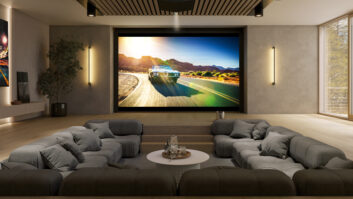You’ve undoubtedly read about Dolby Atmos and DTS:X, the current state of the art of immersive surround sound, both available for commercial cinema and at home. But, there’s a third audio format vying to be the go-to surround solution that you’ve likely heard the least about. It’s called Auro-3D, and it’s pretty cool.

Lest you think Auro is a new player on the scene, it was introduced back in 2006, a full six years before the first movie, Brave, came out with Dolby Atmos. They developed the technology over the next four years and the Auro-3D three-layer, 11.1 channel cinematic speaker layout was launched at the AES Spatial convention in 2010. Auro inventor, Wilfried Van Baelen, introduced the term “Immersive Sound” to better define the surround experience.
Auro-3D divides audio into three different layers: listener/ear layer, height layer, top layer. Layer 1 is the surround layer, or the traditional listener level 5.1 configuration that plays back sounds that occur horizontally to the listening position. Layer 2 is the height layer that “reveals both direct sounds and height reflections…important for our brains to better understand the sounds originating in the first layer.” The third layer plays sounds coming from 90 degrees directly above us, a channel also known as “Voice of God” (VoG), and is generally reserved for film tracks with objects that would pass directly overhead, such as a plane flyover.
The first commercial Auro-3D Studio System was installed in 2011 at Skywalker Sound’s Mix A Studio, and the first film to be recorded in Auro 11.1 was George Lucas’ Red Tails. (The Blu-ray is available with the Auro-3D soundtrack…in Germany.)
There are a few reasons why you likely haven’t heard much about Auro outside of a tradeshow. First, while there are more than 170 commercial theaters in the US outfitted with Auro (you can check a map of locations here), the format is more popular in Europe. Second, there aren’t any home titles available for purchase in the States with an Auro soundtrack. The handful of Blu-ray and UHD movie titles encoded in Auro are currently only sold in Europe. Finally, due to the intense processing requirements, Auro decoding is currently only offered by a handful of manufacturers such as Steinway-Lyngdorf, Datasat, McIntosh, Trinnov Audio, and Storm Audio (co-founded by Auro-3D’s inventor, Wilfried Van Baelen). Most of these are ultra-premium products costing well over $10,000, which keeps Auro from mass-market adoption.
Select Denon and Marantz receivers and pre-pros, however, are capable of being upgraded to Auro-3D for $199. And it happens that my Marantz AV8802A is upgradeable. Thanks to Marantz for gifting me the upgrade license for my review! The upgrade process is fairly simple and is done online, requiring you to register your unit and serial number and enter a 12-digit upgrade ID that is specific to your unit. The actual download and install took about 40 minutes. After installation, new options for Auro appear in the surround mode selections and speaker configurations.
Like Atmos and DTS:X, Auro includes an upmixer that can be used with non-Auro encoded content, which is called “Auro-Matic 3D.” According to Auro, “Unlike most other upmixing technologies on the market, Auro-Matic leaves the original channel of the input source intact instead of steering parts of it to particular speakers. The sophisticated adaptive processing places the original recording in a 3D environment that matches the acoustical properties of the recording, creating an immersive sound field that creates the impression of being in the same environment as where the recording was taking place.
“Depending on the content, more or less spatial cues can be detected for the 3D extrapolation algorithm, resulting in slightly different experiences. To adjust the result to the type of content, as well as to the listeners’ taste, four presets are provided with each defining a different set of parameters for the analysis and emphasizing different characters of the experience.”
The four presets are: Small (“ideal for pop and chamber music or movies with a lot of dialog”), Medium (“best used on jazz music or typical movies and TV shows”), Large (“ideal for recording that are typically recorded in larger spaces e.g. orchestral recordings, action movies with big explosions), and Speech (“ideal for news broadcasts, as these recordings have virtually no inherent spatial information, requiring a different set of parameters for optimal results.”) There is also an adjustment for “3D Strength,” which determines how much upmixing is performed.
While there are various flavors of Auro — from a minimum 8.0 configuration up to 13.1 — the Denon and Marantz solutions support a maximum 10.1 configuration, which includes the traditional 5.1 listener level speakers, plus four height-layer speakers, and the top VoG channel. Ideally, the Auro height channels are positioned directly above the front and side surround speakers. My speakers, however, are arranged in a more Dolby Atmos-friendly 7.2.4 arrangement — with the height speakers arrayed overhead in the ceiling — so I was curious how it would translate to Auro listening.
Unlike Dolby or DTS, which use their own bitstream that is automatically recognized by a processor, Auro-3D signals are encoded into a 5.1 PCM carrier, which is then “wrapped” in a DTS-HD master stream. This ensures backwards compatibility and listening on any system, whether it supports Auro processing or not. When played on a device that has the Auro-3D Engine and Auro-Codec Decoder integrated, the 5.1 gets decoded to the native Auro 11.1 PCM stream.
To better understand the process, Auro supplied me with this signal flow chart:
1. Original Recording in Auro 11.1
2. Encoding Auro 11.1 into a normal 5.1 PCM carrier (fully backwards compatible)
3. Wrap 5.1 PCM into DTS-HD or TrueHD
4. Author onto Blu-ray
5. Playback Blu-ray
6. DTS decoder in AVR decodes the DTS track to 5.1 PCM
7. Two scenarios from here:
1. User doesn’t have Auro installed -> Play back 5.1
2. User has Auro -> Decode 11.1
8. Play Back Auro 11.1 over the Auro speaker setup
Auro sent its latest demonstration disc for me to give the system a workout, which I will review in depth in my next post. Besides copious amounts of demo material, the disc smartly includes numerous test tones that offer a terrific way to confirm that the processor is configured correctly and properly decoding Auro. Among these tests are some that seem to drive full volume tone signals simultaneously from all channels, which sounds like a terrific way to truly find out what your amp is made of, or drive yourself mad with an insanely loud test tone simultaneously emanating from 11 speakers.
I was especially curious to see how my Marantz and speaker layout would handle different channel configurations. When playing the 13.1 channel ID track — which adds two surround back speakers and a front height center speaker — my Marantz played the surround back right and left speaker tones out of the side surround speakers, but by playing the front height left and right simultaneously for the “front height center” speaker, it created a terrific phantom image of this channel, perfectly placing the image in the front center of my ceiling. The same was true for the VoG channel, which played through all four height speakers at once, the sound truly sounded like it was coming from the center top of my ceiling. Good on ya, Marantz! This really showed that, while not ideal, the more typical Atmos-style speaker layout translates well to Auro.
For the demanding customer that wants to make sure their system has all the bells and whistles, Auro definitely offer an additional take on immersive audio, and, as I’ll discuss in my next post, does an especially terrific job with music. Here’s a setup guide, if you’d like to take an even deeper dive: https://www.auro-3d.com/wp-content/uploads/documents/Auro-3D-Home-Theater-Setup-Guidelines_lores.pdf







